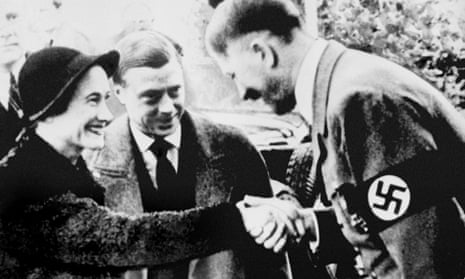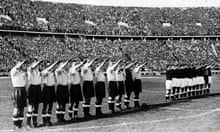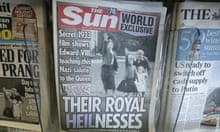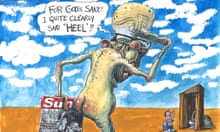When analysing the approach taken by the British royal family to events in Germany in the 1930s, key is the pervasive fear of communism among the aristocracy in Europe. In 1933, Edward (later Duke of Windsor) said of the Nazi regime: “It is the only thing to do. We will have to come to it, as we are in great danger from Communists, too.”
The royal family was also particularly susceptible to such fears because some of their German relatives had from the outset been great admirers of Hitler. To this day, the royal archives have ensured that correspondence between the monarchy and these German relatives remains closed to historians. But, thankfully, relationships always have two sides to them. Other archives – in Germany – reveal the substance of contacts between Queen Mary, her sons – George VI, the Duke of Windsor and the Duke of Kent – and their German cousins.
Among these were members of the houses of Hessen, Coburg, Hanover, Hohenzollern and Waldeck-Pyrmont. Many of them were infatuated with Hitler. These German relatives had an agenda and their agenda was written by Hitler: an alliance with Britain.
Hitler had discovered early on how useful the German aristocracy could be for the Nazi party. Though he made fun of them privately as “degenerate”, he cultivated them vigorously. The glamour of old names still worked in Germany and winning over the aristocracy gave Hitler credibility in conservative circles. After they helped him into office, Hitler also needed German aristocrats to help him on an international level. Central to this was the cultivation of the British establishment, chiefly the aristocracy and the royal family.
In 1933, he was short of international contacts and did not trust his own foreign ministry. As I show in my book Go-Betweens for Hitler, he employed members of the German aristocracy for secret missions to Britain.
The Anglo-German Duke of Coburg – an old Etonian – and the Hessen family, constantly moving between Britain and Germany, offered intimate connections. In scenes reminiscent of Ishiguro’s novel The Remains of the Day, Coburg, together with Ribbentrop, used the country house of his sister Alice for meetings with British politicians. Alice Athlone was married to the brother of Queen Mary.
Carl (“Charlie”) Eduard Coburg, born and raised in England though settled in Germany at 15, was sent over for regular conversations with “David” (Edward VIII) and worked as a back channel during the Rhineland crisis in March 1936. He reported to Hitler that the “British King sees an alliance with Germany as a necessity. It has to become a leitmotiv of British foreign policy”.
When Edward abdicated to marry Wallis Simpson, the Soviet ambassador, Ivan Maisky, correctly saw this as a great blow to Nazi Germany. Still, the Nazis continued to court Edward, now the Duke of Windsor, as well as his brother, George VI, who succeeded him.
Propaganda minister Joseph Goebbels made sure not to attack the royal family during the abdication crisis. This was appreciated in London. A German diplomat reported that George VI “will not forget the attitude of the German press. If he remains on the throne, the German attitude will be useful since he has great sympathies for the Third Reich.”
The Duke of Coburg now cultivated George VI and his wife, Elizabeth. In his diary he calls the royal couple affectionately “Bertie and Elizabeth”. They had been close for some time. In 1933 for example, Elizabeth took the Duke of Coburg on a tour of gardens around Sandringham. She did not seem to mind that Coburg was a particularly ardent Nazi.
These relations have a deeper history still. In the 1920s, “Charlie” Coburg had first supported a rightwing terrorist organisation in Germany and then helped Hitler into power. Parallel to this, the Duke of Windsor also remained a target for the Nazis. The German government paid for his visit to Germany in 1937.
This visit turned into a hugely successful propaganda tour for the regime, with Windsor giving the Nazi salute and meeting all leading Nazis, Hitler included. Coburg was one of many high-ranking Nazis who hosted Edward. A few weeks later, he had tea with Queen Mary again. His contacts seem to have been particularly useful during the Sudeten crisis of 1938.
After annexing Austria in March 1938, Hitler had threatened to “smash” Czechoslovakia next. During this crisis, Coburg was sent by Hitler to London to talk to “Bertie and Elizabeth” several times. His mission was successful; Hitler got the Sudetenland.
It must not be forgotten that George VI supported Chamberlain’s appeasement policy, together with its anti-Soviet rationale, all along and was pleased when agreement was finally reached with Hitler. The Queen’s grandmother, Queen Mary, backed her son wholeheartedly and was furious about any criticism of the Munich agreement concluded in September 1938.
Giving in to Hitler did not help. Half a year later, he took over the rest of Czechoslovakia by force. But, even then, the royal family did not give up immediately. As late as summer 1939, George VI’s brother, the Duke of Kent, hoped the war could be averted by using their Hessen relatives as a back channel to Hitler.
But it was too late. When Hitler signed his pact with Stalin in August 1939 and marched into Poland less than a month later, the last royal appeasers must have realised that they had been played all along. For the next 75 years, their courtiers had good reason to worry their Nazi flirtations would come to light.
Like most of those who wanted to give Germany the benefit of the doubt in the 1930s, the point of no return was the Blitz in 1940. From then on, Queen Elizabeth and George VI were most certainly mobilised in defence of Britain.
Thus we should not be surprised to find that the history of the royal family in this period was not unlike that of others, committed to the folly of appeasement on the eve of the Second World War. But we should at least be able to follow the story in detail from within the royal archives.
Dr Karina Urbach is a senior research fellow at the Institute of Historical Research, University of London. She is the author of Go-Betweens for Hitler (Oxford University Press)







